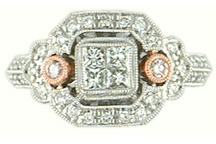Diamonds - An Overview
Diamonds are the birthstone for
those of us lucky enough to born in April. The rest of us need to adopt diamonds
simply because they are beautiful, durable, rare, and exciting to see. Every diamond
in the world is truly unique - just like us humans.
It takes 250 tons of earth to be sifted to find one carat of
rough diamond crystals. Only one diamond crystal in a million carats mined
will be large enough to cut into a one carat diamond. Diamonds have been found
in every color of the rainbow. If the color is vivid the diamond is considered a
fancy color. Fancy colored diamonds are priced based on the rarity of the
color.
Most diamonds exhibit a slight tint of color, typically, a light yellow or
light brown. The lighter the tint the more rare the gemstone. Therefore, a
colorless diamonds graded D on the GIA color scale will command a higher value than a
diamond that is in the near colorless range, graded as H.
Today there are many treatment used to enhance colored or mask the the
extent of inclusions in diamonds. Diamonds can be drilled with a laser and then boiled in
acid to bleach the color from dark inclusion.
Diamonds can be filled with a glass like substance that masks the location and appearance of internal fractures. Clarity enhanced diamonds are not as durable as untreated diamonds.
Repair work or cleaning performed on an item of jewelry containing treated
diamonds is limited by the nature of the foreign material used in the treatment
process.
Diamonds can be exposed to radiation salts, subatomic particles in a
cyclotron or to neutron bombardment in an effort to improve the stone's color.
Often these colors are more vivid than the colors found in nature.
Diamonds can be coated to improve color. A coating that resist ordinary
solvents can mask a diamond's yellow body color.
It is best to purchase your diamonds from a trained gemologist that is
able to identify these treatments and protect you from purchasing a treated diamond at an
untreated diamond's price.
The art of grading a diamond for value takes years of training and more years of experience. If you don't know diamonds, choose your diamond dealer with care. Look for individuals who are Graduate Gemologists or Certified Gemologists with the American Gem Society

Soot from a smoky candle soft, black, opaque, so worthless it is wiped away as a nuisance. This is the element called carbon. The diamond in a queen's tiara - harder than any other natural substance, colorless, transparent, flashing with the brilliance of fresh dew, so costly it is worth king's ransom-this also is carbon, nothing more, nothing less. The difference between them is this: soot forms at ordinary temperature and pressure; diamonds at a temperature and pressure so high it is equivalent to that exists 150 miles below the earth's surface."
"The Mystique of Diamonds" A diamond is forever brochure.
The Four C's
We often begin our discussion of diamonds by listing the 4 C's, Carat, Color, Clarity, and Cut. Unfortunately, these characteristics are often misunderstood.
The Diamond Promotion Service, in an attempt to improve communication, devised a four sided triangular visual aid. Carat is listed on one side. Color, clarity and cut are listed on the three remaining sides. The point of the visual aid is to explain rarity and how it affects the value of a diamond. Diamond with a tint of yellow color and relatively common as well are gemstone with numerous inclusion. Large diamonds are quite rare. Diamonds over one carat are one in a million. Putting all this together a large diamond, with little or no body color and very small inclusions is very rare and correspondingly will demand a higher price in the marketplace than a more common specimen.
That's where most discussions end. We have talked about three of the 4 C's and most people think they know all they will ever need to know about diamonds.
That's not the case, before we can determine value we need to explore the fourth C, Cut.